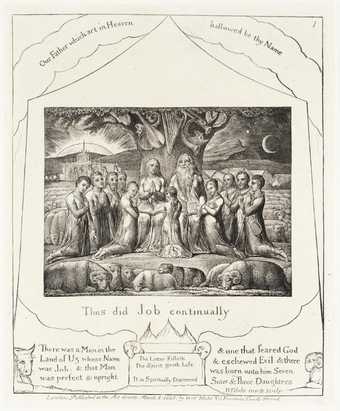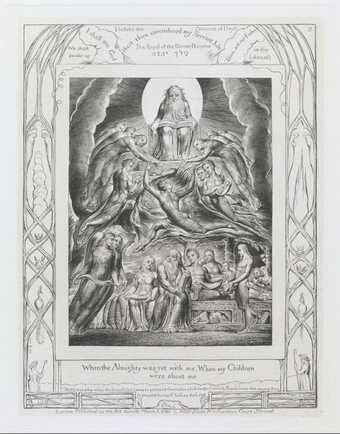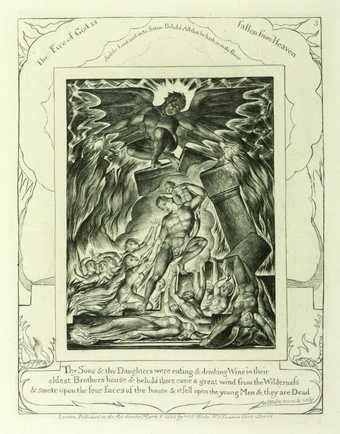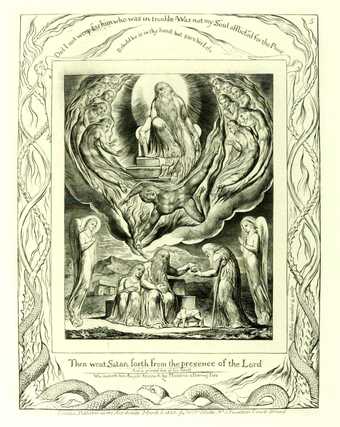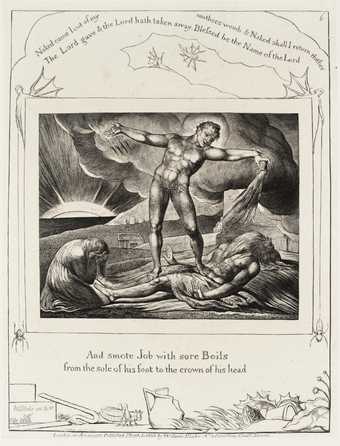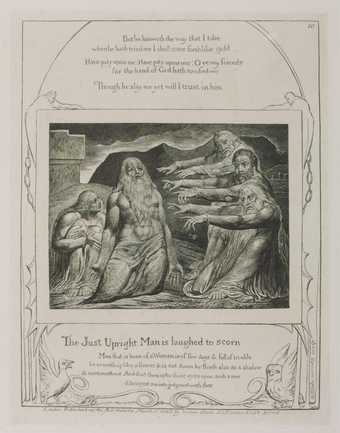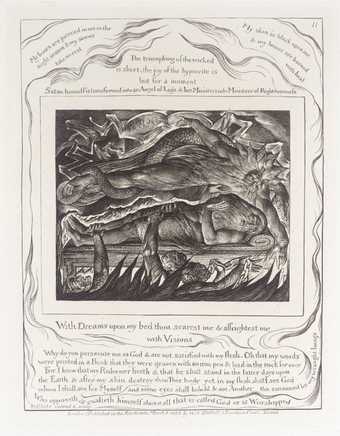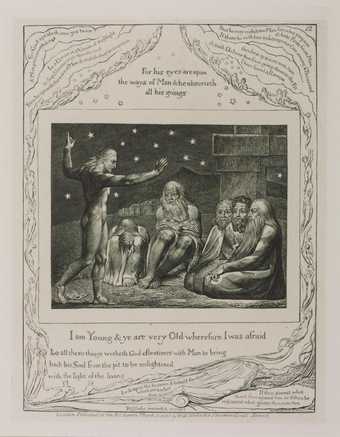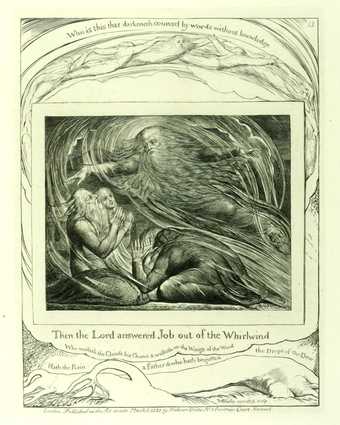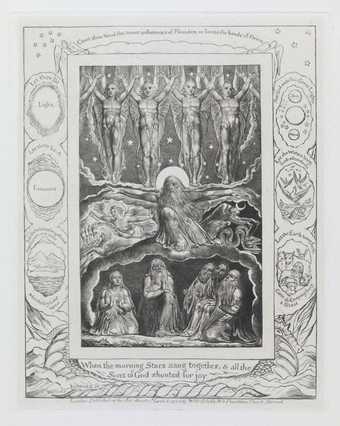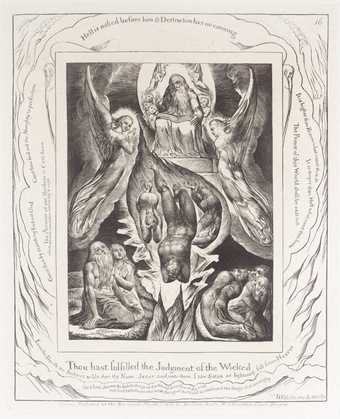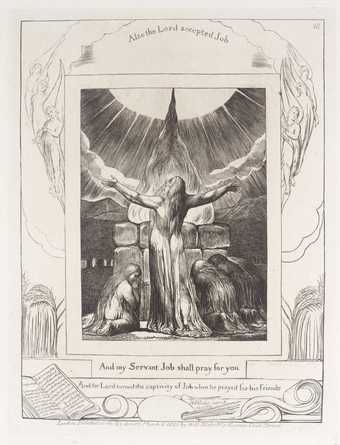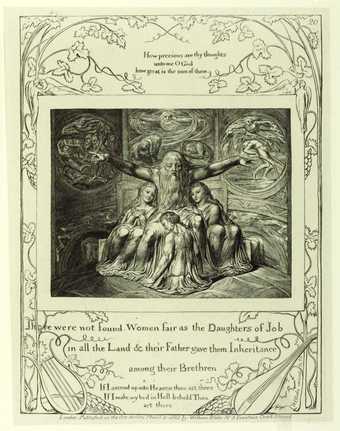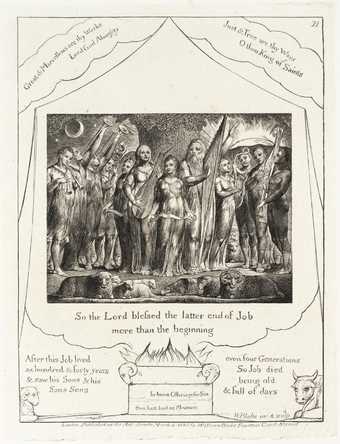
In Tate Britain
Prints and Drawings Room
View by appointment- Artist
- William Blake 1757–1827
- Medium
- Line engraving on paper
- Dimensions
- Image: 198 × 153 mm
- Collection
- Tate
- Acquisition
- Purchased with the assistance of a special grant from the National Gallery and donations from the Art Fund, Lord Duveen and others, and presented through the Art Fund 1919
- Reference
- A00018
Display caption
In Blake's series of twenty-one illustrations to the Book of Job this plate comes immediately after the one which shows Job being tortured by a rash of boils. Here he lies exhausted and resigned, supported by his wife. The words in the top margin are from Job's reproof to his wife after she has said to him 'curse God, and die' because of the trials he has suffered. Job's comforters, Eliphaz, Bildad and Zophar remain with him for seven days and nights. The small figures in the margins convey a sense of sorrow and patience. These are characteristics of Job's state of mind at this moment and for the foreseeable future.
Gallery label, September 1998
Does this text contain inaccurate information or language that you feel we should improve or change? We would like to hear from you.
Catalogue entry
A00018 [from] Illustrations to The Book of Job: Engravings
1823–6/1874 [A00012-A00032; T05845; complete]
A 00012–32 /-
Twenty-two line engravings on india paper laid on drawing paper approx. 510×345 (20×13 1/2)
Purchased with the assistance of a special grant from the National Gallery and donations from the National Art-Collections Fund, Lord Duveen and others, and presented through the National Art-Collections Fund 1919
PROVENANCE John Linnell; his heirs, sold Christie's 15 March 1918 (183) £33.12.0.bt Martin for the donors
LITERATURE Gilchrist 1863, 1, pp.283–4, 297; Wicksteed 1910 and 1924; Russell Engravings 1912, 102–15 no.33: Keynes Bibliography 1921, pp.179–82 no.55: Binyon and Keynes 1935, series repr. vol.VI; Keynes Engravings 1950, pp.16–17, series repr.pls. 42–68; Keynes Writings 1957, pp.869–70, 872, 874, 876–7; S. Foster Damon, Blake's Job 1966, series repr.; Bentley Blake Records 1969, pp.234 n.i, 277–397 passim, 586–605; Andrew Wright Blake's Job: A Commentary 1972, series repr.; Lindberg 1973, pp.24–32, 40–52, 167–76, 183–352 nos.0A–21A, series repr.; Bentley Blake Books 1977, pp.517–24 no.421; Bindman Graphic Works 1978, pp.486–7 nos.625–46, series repr.; Mitchell 1978, pp.41–2; Essick Printmaker 1981, pp.92, 105, 220, 234–50, 252; Robert N. Essick, ‘Blake's Engravings to the Book of Job; An Essay on their Graphic Form with a Catalogue of their States and Printings’ in David Bindman, ed., William Blake's Illustrations of the Book of Job 1987, pp.35–101.
John Linnell, who had commissioned the second set of watercolour illustrations to the Book of Job in 1821, entered into a formal agreement with Blake for the engravings on 25 March 1823: Linnell was to pay Blake £5 a plate or £100 for the set, and in addition he agreed to give Blake an extra £100 if the profits of the work made this possible. The agreement was for twenty engravings though in the event twenty-one subjects were engraved together with a title-page. On 5 March 1825 Linnell went with Blake to the printer J. Lahee to see proofs being taken. The series is dated 8 March 1825 but the final engravings do not seem actually to have been ready until the end of March 1826 (Bentley 1969, pp.277, 300 and 327). At this time 215 sets of engravings marked ‘Proof’ were issued; these should be distinguished from the working proofs, on some of which Blake tried out designs for the borders. The word ‘Proof’ was then deleted (traces can be seen on A00013) and a further 100 sets were printed on drawing paper. According to John Linnell Jr, writing to Bernard Quaritch on 6 May 1892, Linnell, after the 1826 printing, ‘put the plates away, & they were never again used after this time until the year 1874. At this time my father...had one hundred copies printed from the plates upon India paper’. Although the distinctive cover is now missing, it seems that the Tate Gallery's copies of the engravings are from this 1874 printing. The original plates were given by Herbert Linnell to the British Museum Print Room on 28 May 1919.
Each engraving is inscribed ‘W Blake inv. & sculp’. In addition each is inscribed in the lower margin with variations of the text ‘London. Published as the Act directs March 8:1825 by William Blake No3 Fountain Court Strand’; the first actual design (A00012) is mistakenly dated with the year 1828 and ‘Willm’ is sometimes substituted for ‘William’, while the punctuation is also slightly varied.
More importantly, the borders of each design bear a number of inscriptions taken from the Bible or with variations of biblical texts. These add a verbal gloss to the designs which in themselves embody Blake's critical reaction to the original story as set out in the Old Testament. The fullest analysis is in Lindberg though Wicksteed, Damon 1966 and Wright also contain full commentaries. Blake's interpretation of his text is only given in summary form in this catalogue.
These engravings were formerly inventoried as nos.3372 i–xxii. The new inventory numbers omit the title-page.
A00018 Job's Comforters
Line engraving 198×153 (7 13/16×6); platemark 218×170 (8 5/8×6 11/16)
Inscribed ‘WBlake inven & sculpt’ b.r., ‘London. Published as the Act directs March 8: 1825 by William Blake N3 Fountain Court Strand’ below, ‘7’ t.r., and with texts given below
Illustration no.7: Job, ii, 9–12. Blake's main title is a quotation from Job, ii, 12 reflecting the reaction of the three comforters, Eliphaz, Bildad and Zophar: ‘And when they lifted up their eyes afar off & knew him not they lifted up their voice & wept. & they rent every Man his mantle & sprinkled dust upon their heads towards heaven’. Above, Blake quotes Job's response to his wife, ‘What! shall we recieve Good at the hand of God & shall we not also recieve Evil’ (Job, ii, 10). At the foot of the page Blake quotes the comment from James, v, 11: ‘Ye have heard of the Patience of Job and have seen the end of the Lord’.
Although the King James Bible states that Job is sitting on ‘ashes’ (Job, ii, 8) Blake follows traditional imagery, and the Septuaginta and Vulgate translations ‘dunghill’, though he makes it look more like a heap of straw. The pose of Job and his wife echoes that of ‘A Lamentation over the Dead Christ’ and Lindberg demonstrates the parallel with an engraving after Michelangelo's ‘Pietà’ in St Peter's (repr. Lindberg 1973, pl.107). That this was a conscious imitation is supported by the fact that the architectural form on the extreme right suggests the Cross. The three comforters on the left rush in left foot forward demonstrating, according to Wicksteed's theory, that they are the ‘Corporeal Friends’ who are ‘our Spiritual Enemies’ (Millon plate 4 and Jerusalem plate 44/30; Keynes Writings
1957, pp.484, 655).
Published in:
Martin Butlin, William Blake 1757-1827, Tate Gallery Collections, V, London 1990
Explore
- architecture(30,960)
- townscapes / man-made features(21,603)
-
- townscape, distant(8,109)
- emotions and human qualities(5,345)
-
- suffering(161)
- actions: expressive(2,622)
-
- comforting(76)
- weeping(68)
- arm / arms raised(839)
- beard(206)
- group(4,227)
- Bible: Old Testament(381)
-
- Job(24)
- Job’s wife(13)
- Job, chapter 2(4)
You might like
-
William Blake Job and his Family
1828, reprinted 1874 -
William Blake Satan before the Throne of God
1825, reprinted 1874 -
William Blake Job’s Sons and Daughters Overwhelmed by Satan
1825, reprinted 1874 -
William Blake Satan Going Forth from the Presence of the Lord, and Job’s Charity
1825, reprinted 1874 -
William Blake Satan Smiting Job with Sore Boils
1825, reprinted 1874 -
William Blake Job Rebuked by his Friends
1825, reprinted 1874 -
William Blake Job’s Evil Dreams
1825, reprinted 1874 -
William Blake The Wrath of Elihu
1825, reprinted 1874 -
William Blake The Lord Answering Job out of the Whirlwind
1825, reprinted 1874 -
William Blake When the Morning Stars Sang Together
1825, reprinted 1874 -
William Blake The Fall of Satan
1825, reprinted 1874 -
William Blake The Vision of Christ
1825, reprinted 1874 -
William Blake Job’s Sacrifice
1825, reprinted 1874 -
William Blake Job and his Daughters
1825, reprinted 1874 -
William Blake Job and his Family Restored to Prosperity
1825, reprinted 1874

